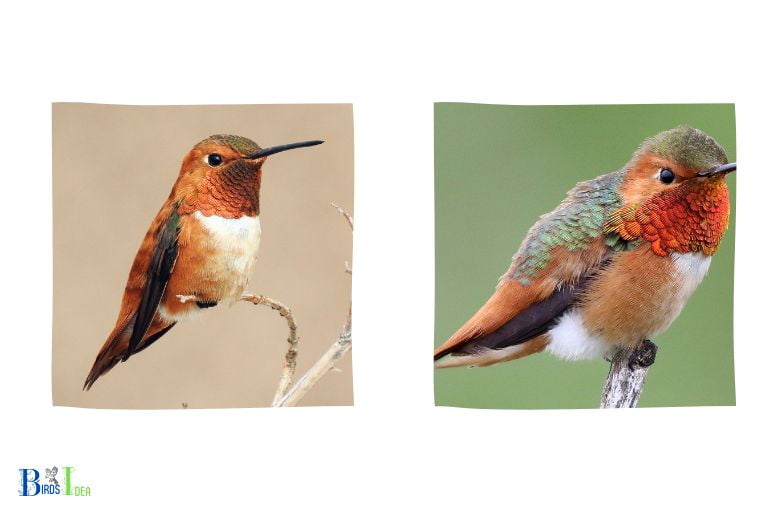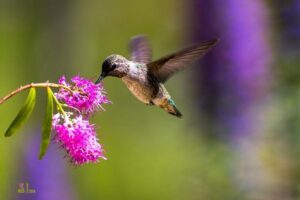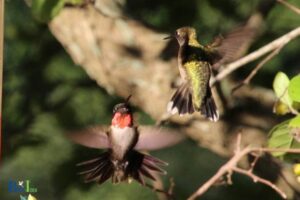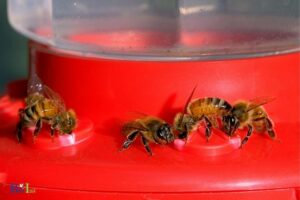Rufous Vs Allen’s Hummingbird: 6 Comparisons!
Rufous and Allen’s hummingbird are both species of small hummingbirds that are found in North America. The most obvious difference between the two is their appearances.
Rufous hummingbirds are relatively small with a brownish-red back and a green chest, while Allen’s hummingbirds have a green back and a red-orange throat and chest.
The Rufous hummingbird tends to have a more extensive rusty coloration on its back and flanks.
In contrast, the Allen’s hummingbird generally exhibits a more greenish back. Their migratory patterns also differ significantly.
Overall, Rufous and Allen’s hummingbirds are quite similar but have distinct characteristics that distinguish them from one another. Most notably, their appearance, habitats, and diets.
Rufous hummingbirds show a more pronounced rufous coloration, while Allen’s hummingbirds exhibit a more greenish back.
6 Comparisons of Rufous and Allen’s Hummingbird
| Comparison | Rufous Hummingbird | Allen’s Hummingbird |
| Habitat | Mountain meadows, open woods | Coastal regions, scrubland |
| Size | 7.5–9 cm in length | 8–10 cm in length |
| Weight | 2–5 g | 3–5 g |
| Wingspan | 11–12 cm | 10–11 cm |
| Diet | Flower nectar, insects, spiders | Flower nectar, insects, spiders |
| Nest | Cone shaped, in trees | Small, cup-shaped, in shrubs |
Key Takeaway

Five Facts About: Rufous and Allen’s Hummingbird
DID YOU KNOW
According to National Geographic, Rufous hummingbirds migrate up to 3,000 miles twice a year, while Allen’s hummingbirds migrate up to 2000 miles.
Comparing Rufous and Allen’s Hummingbirds
Rufous and Allen’s hummingbirds are both relatively small birds that can be found near the Pacific coast in North America.
They both have similar habitat preferences and feeding behaviors, making them common competitors in the wild.

The main differences between these two birds are in their size, coloration, and migratory patterns. Rufous hummingbirds are larger with a bright orange-red body and darker wings.
Allen’s hummingbirds, on the other hand, are smaller with a mostly green body and bright red throat.
Rufous hummingbirds are migratory, while Allen’s hummingbirds are mostly resident, only performing short migrations to find food.
Overall, Rufous and Allen’s hummingbirds are similar species but have distinct differences that set them apart.
Key Differences
Size: Rufous hummingbirds are larger than Allen’s hummingbirds
Coloration: Rufous hummingbirds have an orange-red body and darker wings, Allen’s hummingbirds are mostly green and have a bright red throat
Migration Patterns: Rufous hummingbirds are migratory while Allen’s hummingbirds are mostly resident and perform short migrations to find food.
Physical Differences Between Rufous and Allen’s Hummingbirds
Rufous and Allen’s hummingbirds are two of the smallest species of North American hummingbirds.
While they may look similar and belong to the same family, there are several distinct physical differences between them that can be used to tell them apart.
By carefully observing these physical differences, bird-watchers can easily identify which species of hummingbird they are looking at.
Habitats and Migration Patterns of Rufous and Allen’s Hummingbirds
Rufous and Allen’s Hummingbirds are two species of hummingbirds, both of which migrate seasonally in North America.
Both species have similar migration patterns and habitats, although there are a few distinct differences.

Rufous Hummingbirds:
- Migrate from the western United States and Canada down to Central America for the winter.
- During the summer, they can be found in open forests, meadows and gardens.
Allen’s Hummingbirds:
- Migrate from the western United States and Canada to Southern California and Baja Mexico in the winter.
- During the summer, they inhabit coastal areas, suburban gardens and chaparral.
Overall, Rufous and Allen’s Hummingbirds share many common traits, including their habitats and migration patterns. However, they do have distinct differences that separate them as two unique species.
“The greatest beauty of nature lies in its difference – even two species of hummingbirds”
birdsidea
Dietary Differences of Rufous and Allen’s Hummingbirds
Rufous and Allen’s hummingbirds are two species of hummingbirds that differ in size, appearance, and habitat. They also have different dietary needs.

The Rufous hummingbird is a small species that feeds mostly on nectar, insects, and spiders. They have a larger bill than the Allen’s hummingbird, allowing them to feed on a wider variety of flowers.
Their diet also includes sap and small fruits.
The Allen’s hummingbird is smaller than the Rufous and has a shorter bill. It mainly feeds on nectar and insects.
They are able to hover in front of flowers to get their nectar and are also known to feed on spiders and caterpillars. They also consume small amounts of fruit and sap.
Overall, the diet of both species is quite similar, but the Rufous hummingbird is able to feed on a wider variety of items due to its larger bill.
Coloration Differences During Breeding and Non-Breeding Seasons
Coloration differences during the breeding and non-breeding seasons are quite common in some birds, mammals, and reptiles, and can have a significant impact on the animal’s behavior.

In birds, the breeding season is accompanied by the development of bright, colorful feathers, while non-breeding season feathers tend to be duller in color.
This change is largely driven by the hormones testosterone and estrogen, which are produced in greater abundance during the breeding season.
This helps to attract mates, as well as signal to predators that the individual is healthy and successful.
Mammals also experience color changes depending on the season. For example, arctic fox fur changes from a light brown in the summer to white in the winter, allowing them to be nearly invisible in the snow.
Similarly, some deer species develop darker fur in the winter, allowing them to blend into the shadows of the forest.
Reptiles also experience color changes depending on the season. Many species become more colorful when the temperature is warmer, allowing them to be more visible during the days when they are most active.
In conclusion, coloration differences during the breeding and non-breeding seasons are quite common in some birds, mammals, and reptiles and can have a significant impact on the animal’s behavior.
The changes in coloration can help attract mates, help them blend into their environment, and signal to potential predators that they are successful and healthy.
Similarities of Rufous and Allen’s Hummingbirds
Rufous and Allen’s Hummingbirds are both species of hummingbirds found in the western parts of North America. They have a few similarities that make them unique.
Though they have many similarities, there are also some differences. Rufous Hummingbirds have a stripe of white around their eyes, while Allen’s Hummingbirds do not.
The males of Allen’s Hummingbirds have green throats, while the males of Rufous Hummingbirds have a bright red gorget.
Also, Rufous Hummingbirds are found in the northern and western parts of North America, while Allen’s Hummingbirds are found in the western parts of the United States.
Overall, both species of hummingbirds have many similarities, but their distinctions make them important and interesting to study.
Summary of Rufous and Allen’s Hummingbirds
Rufous and Allen’s Hummingbirds are a species of small, colorful birds found in the western United States and Canada.
They are very small in size and have a colorful plumage. They are known for their energetic and acrobatic flight and their high-pitched songs.

Rufous and Allen’s Hummingbirds have a distinct physical appearance. They have a dark brown back, rufous-colored sides and flanks, and a white throat.
The males have a greenish-blue forehead and crown. The birds have long, thin bills that are adapted for feeding on nectar from flowers.
Rufous and Allen’s Hummingbirds feed mainly on nectar from flowers, but they will also eat insects, especially in summer.
They forage for food both in flight and in vegetation. They are able to hover in the air and move quickly from flower to flower.
Rufous and Allen’s Hummingbirds build nests from moss and spider web, which are usually suspended from branches. The nest is lined with feathers and down.
The female typically lays two white eggs. The incubation period is about 17 days.
Notable Features of Rufous and Allen’s Hummingbirds:
- Small, colorful birds
- Dark brown back, rufous-colored sides and flanks, and a white throat
- Long, thin bills
- Feed on nectar from flowers and insects
- Can hover in the air and move quickly from flower to flower
- Build nests from moss and spider web
FAQ of Rufous Vs Allen’s Hummingbird
What is the main difference between a Rufous and Allen’s hummingbird?
What habitat do Rufous and Allen’s hummingbirds live in?
Are Rufous and Allen’s hummingbirds different sizes?
Do Rufous and Allen’s hummingbirds have different diets?
Are Rufous and Allen’s hummingbirds found in the same areas?
Conclusion
Rufous and Allen’s hummingbirds are both captivating species of small hummingbirds that exist in North America.
Despite their similarities, their appearances, habitats, and diets differ, making them distinct species.






